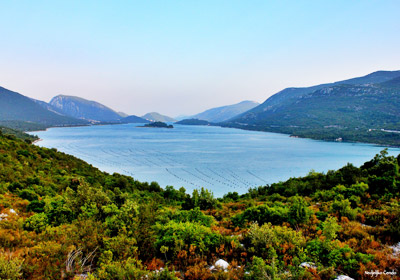Dalmatian Islands, Croatia

Dalmatian Islands, Croatia
The Learning Area on Dalmatian Islands, Croatia, encompasses territories of LAG Škoji, LAG Brač and LAG 5, covering the area from Dubrovnik-West Coast in Dubrovnik-Neretva County to the island of Šolta in Split-Dalmatia County.
Farming is dominated by permanent crops (olives, figs, caroub, almonds), but also supports remnants of pastoral systems as well as cultivation of medicinal and aromatic plants.
The key issues faced by the area are: agricultural and rural development policies, abandonment and "reconquest" of marginal Mediterranean lands. The area is a ground for local action group activities and successful participatory projects.
For more information on the HNV farming systems, challenges and innovations, see the innovations page of Dalmatian Islands.
More info: www.lag5.hr/hnvlink/
Contact person:
Participatory approach
The Dalmatian Islands Learning Area (LA) is a mosaic landscape scattered across the Adriatic Sea. Croatia is the newest member of the European Union and still in the process of adopting the Acquis. The country is in the beginning stages of implementing the Common Agricultural Policy’s (CAP) Pillar 2 agri-environmental measures. Although the average farm in Croatia is around 2ha, farms in the LA are only about 1,7 ha. These small farms are characterized by diversified production, and they are entrenched with the local tourist economy. HNV farmland landscape provides the setting for tourism, which supports the small-scale HNV farms through providing a market for the farm goods.
It is in this setting that Local Area Group LAG 5, as the national coordinator and one of the three LAG's that cover our LA, started building a community of HNV farming actors in the islands. LAG 5 has used a range of participatory methods for framing and shaping the project. The team has held informal bilateral meetings with stakeholders on most of the islands. Through face to face meetings and virtual group discussions, LAG 5 has linked HNV farming to tourism activity and to the local and regional agriculture knowledge and information systems (AKIS) representatives and also conducted education on the use of agri-environmental measures. The team ensured inclusion of stakeholders through different fairs and social occasions where it showcased HNV farming products and practices from the LA.
In order to address local LA issues and the nascent implementation of agri-environmental measures, the team focused the participatory process on both the local level end users and on the national AKIS. Because HNV farming in the mosaic landscape with a network of dry stone walls produces agri-environmental, economic and safety benefits (the latter in the form of forest fire prevention and improved water collection for fields), the team targeted communication activities to AKIS on multiple scales. It also collaborated with international organizations such as SMILO-Programme for the labelling process for small sustainable islands and has participated in drafting the new Island Act.
To date, the team’s major effort is focused on the creation of an engaged network of national actors that will foster the process of landscape restoration and maintenance of the mosaic landscape in the Dalmatian islands. The HNV vision, innovation, and innovation gaps are based around these aims. The participatory approach, initiated at the preparation of the HNV-Link project proposal and currently ongoing, has kick-started the creation of new projects to solve specific problems common to the islands in the LA. According to the participating actors, actions are needed specifically for the development of island-based short value chains, establishment of islander producers’ association, enhancement of the pastoral activities, and improvement of the national legislation.
The LA coordinator acts as a knowledge broker to translate the EU norms to the local context of the LA and as an active participant of the HNV farming network who brings in the perspective of the LA’s HNV farming actors. It is with this process that LAG 5 has formed a network of scientific researchers, practitioners, farmer associations, AKIS, and the public authorities for the Dalmatian Islands LA.
Table 1 List of key HNV-Link activities which together detail the participatory approach adopted in our LA and its expansion to other islands in Croatia (up to April 2018).
| Activities | Date | Number of participants |
|---|---|---|
| Presentation of the project on LA Dalmatian | 50 | June 7, 2016 |
| Meeting of the working group LA | 8 | June 18, 2016 |
| Workshop “mosaic landscapes” | 21 | August 25, 2016 |
| Promoting the HNV landscape | 130 | September 3, 2016 |
| Working meeting on Mljet | 7 | September 20, 2016 |
| Linking the islands- MIC | 5 | September 21, 2016 September 24, 2016 |
| Meeting with the | 4 | October 27, 2017 |
| Network meeting in Ston | 15 | November 22, 2017 |
| Evaluation meeting on how to bridge the gap between research and practice | 17 | January 16, 2018 |
| Informal meetings- field work | 232 | February- March 2017 |
Gallery
Video
Disclaimer: This document reflects the author's view and the Research Executive Agency is not responsible for any use that may be made of the information it contains.
Outputs
-
 Dalmatian Islands, Croatia LA
Dalmatian Islands, Croatia LA
- Baseline Assessment
- Report from the Innovation seminar (website)
- National Language Report Innovation seminar
- Innovation report
- Participatory approach, Dalmatian Islands, Croatia
- Dalmatian Islands, Croatia, HNV-Link Final Conference (Poster)
- Action Plan
(April, 2019)The compilations of the respective reports from all project learning areas - Baseline Assessments, Reports from innovation seminars, and Compendium of Innovation - can be found in 'Outputs'. Reports from the Innovation seminars are in the national languages, all other materials are in English.





